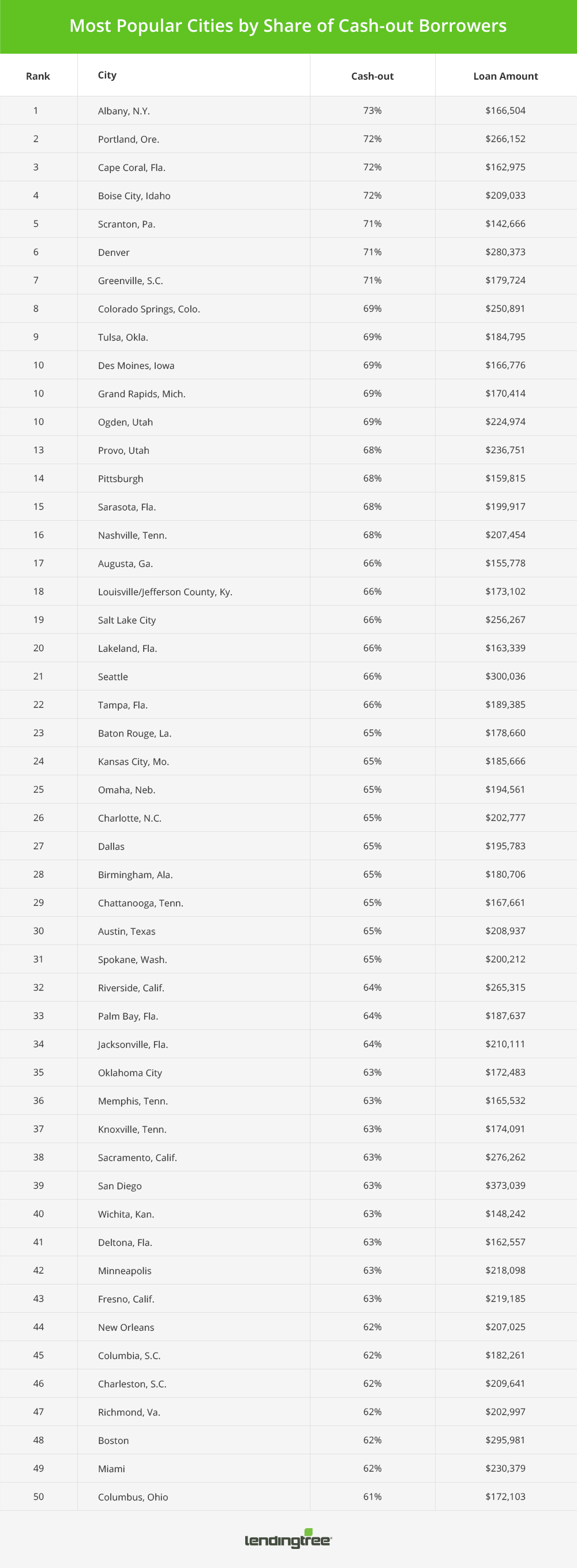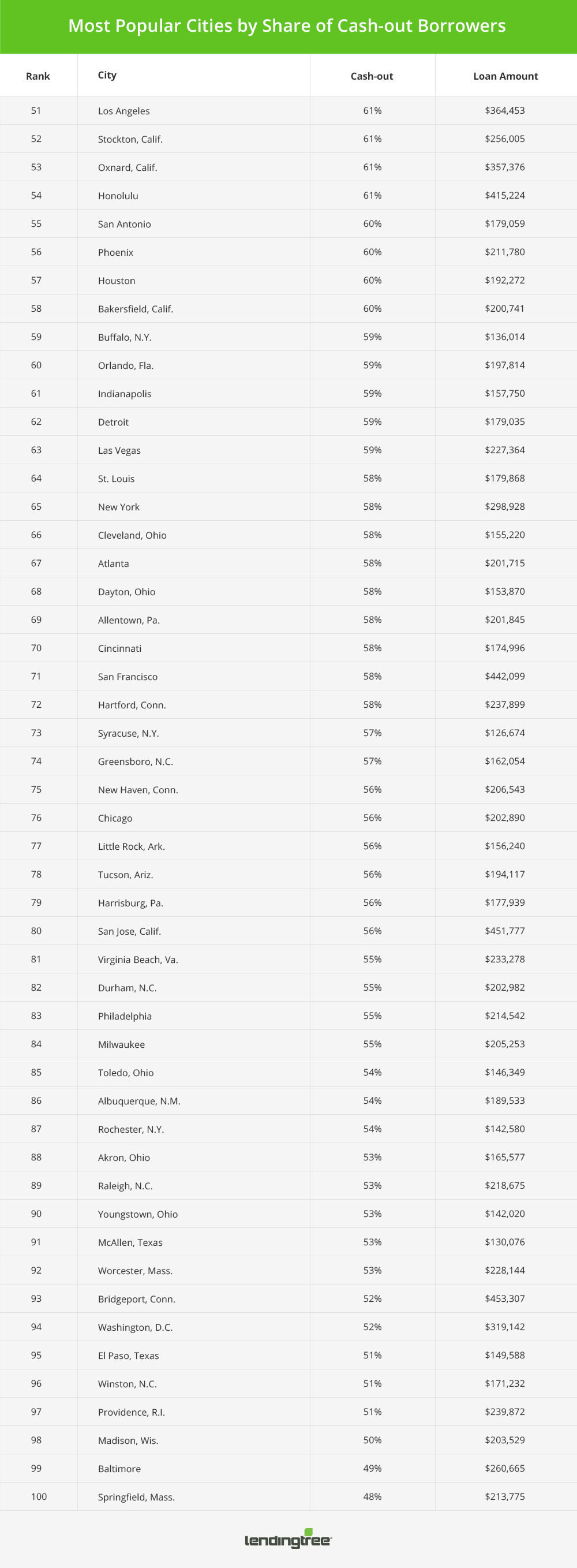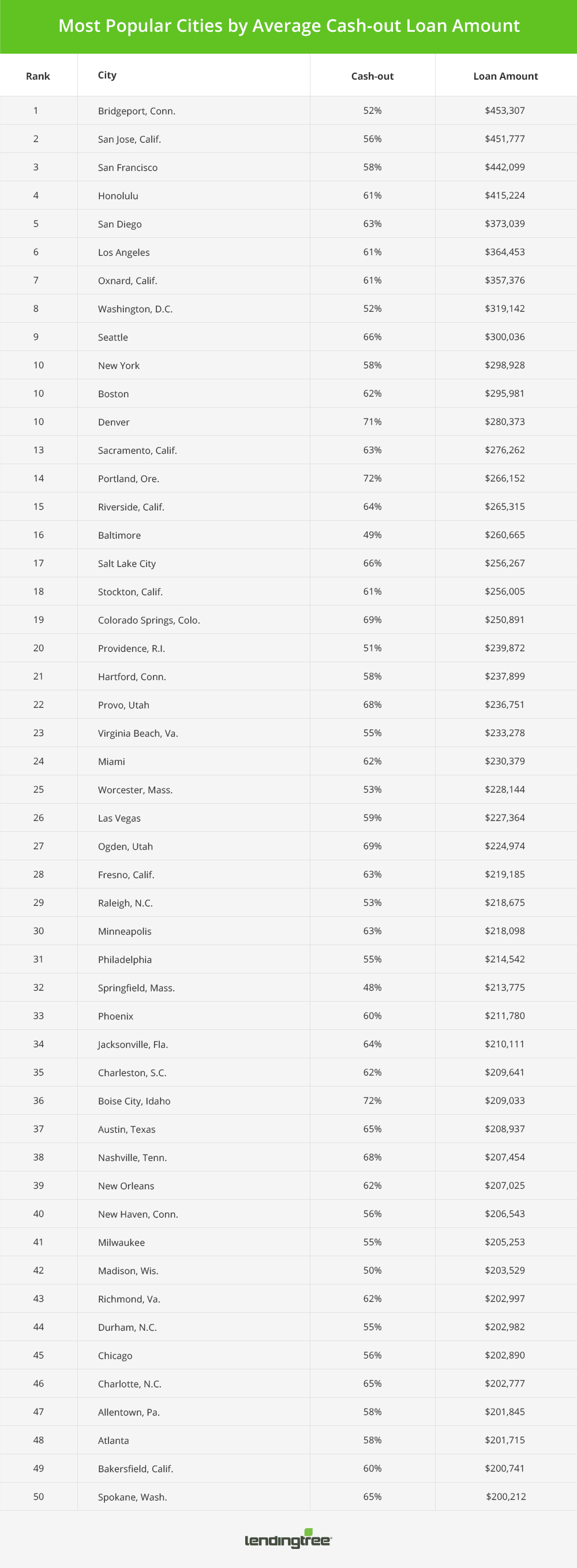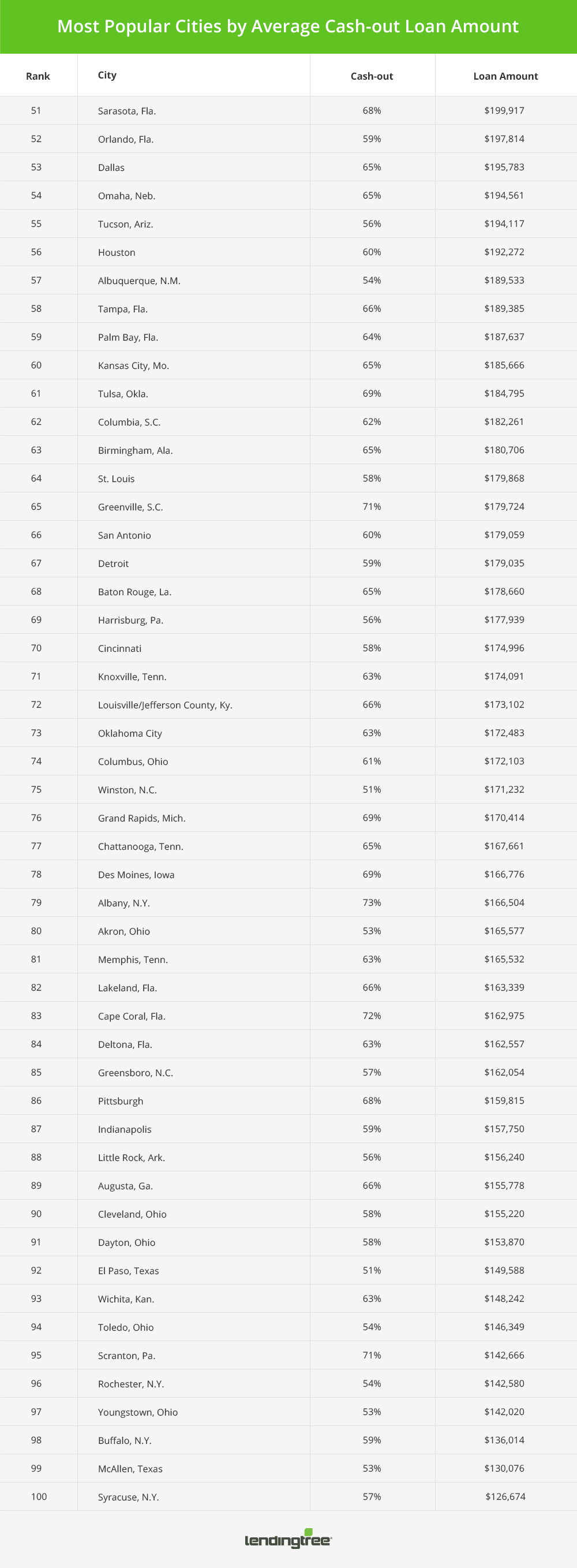LendingTree Ranks Cities With the Highest Share of Cash-Out Refinance Borrowers
Mortgage rates have increased over the past six months which has led to a decline in mortgage refinance applications. At the same time, home prices continue to increase at a robust pace. In such an environment, borrowers who have had meaningful appreciation in their homes can still have an incentive to access this equity via a cash-out refinance, in which the new mortgage balance is higher than the outstanding balance prior to refinancing. This change in the mix of refinances — less interest rate-driven loans and more driven by the pursuit of equity extraction — leads to an increase in the share of cash-out loans as a proportion of all refinances.
Borrowers can use the cash extracted to perform home renovations, consolidate debt, purchase appliances or cars, go on vacation, start a business or even as a down payment on a second home.
LendingTree data has shown this trend toward more cash-out refinancing. Cash-out refinance loans have risen to 62% of all refinances in Q1 2018, up from 54% in Q1 2017. However, not all areas of the country have the same propensity to access cash through refinancing their mortgages, and we used our data to assess where it was most prevalent over the past year.
LendingTree analyzed mortgage requests and offers for refinance borrowers between March 1, 2017 and March 1, 2018, based on the location of the property to be mortgaged. The city rankings are generated from the percentage of total refinance mortgage funded that included a cash-out portion of the loan.
Cities with the highest share of cash-out borrowers
#1 Albany, N.Y.
Share of refinance mortgages funded with cash-out portion: 73%
Average loan amount: $166,504
#2 Portland, Ore.
Share of refinance mortgages funded with cash-out portion: 72%
Average loan amount: $266,152
#3 Cape Coral, Fla.
Share of refinance mortgages funded with cash-out portion: 72%
Average loan amount: $162,975
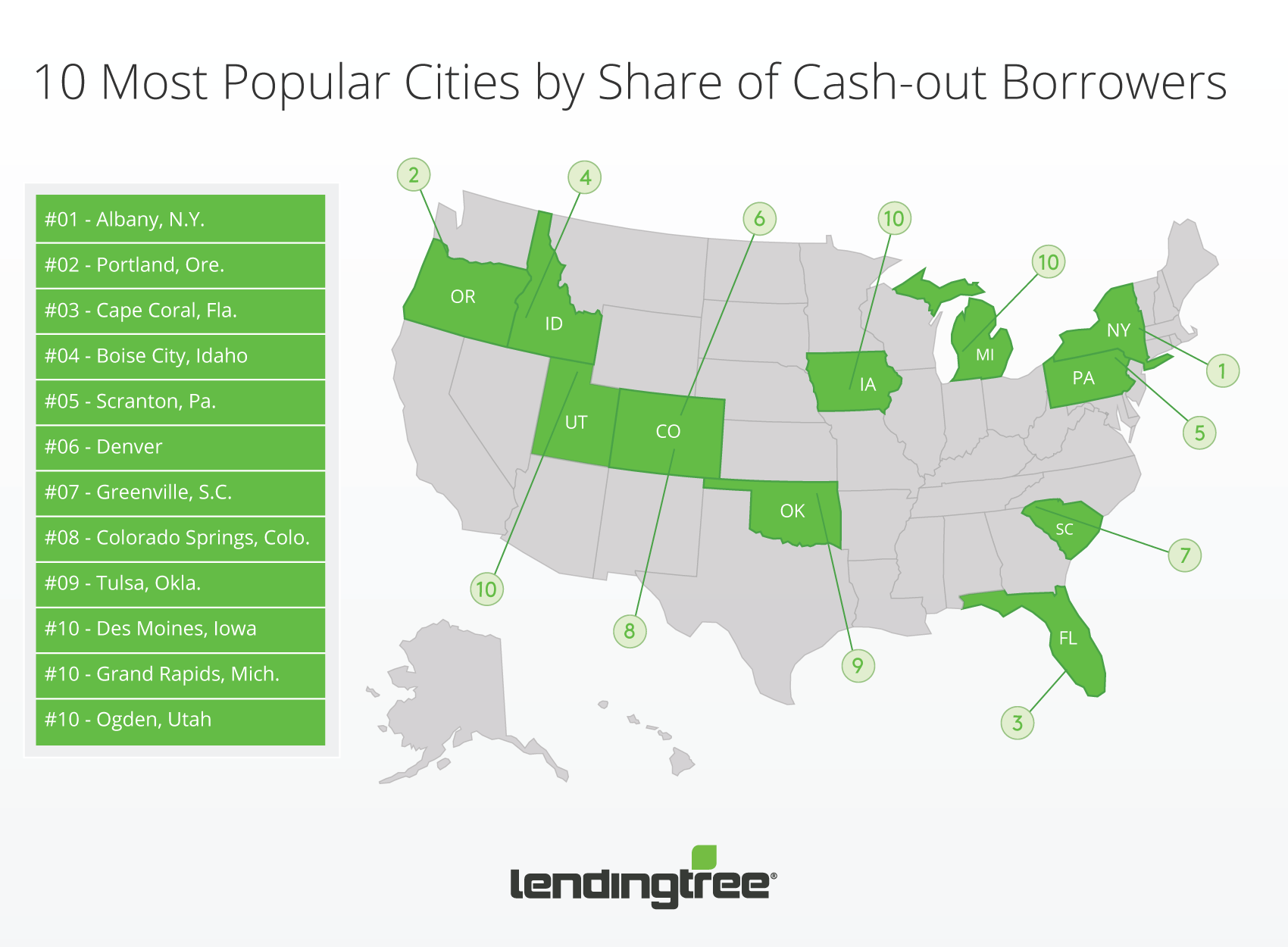
Cities with the highest cash-out loan amounts
#1 Bridgeport, Conn.
Share of refinance mortgages funded with cash-out portion: 52%
Average loan amount: $453,307
#2 San Jose, Calif.
Share of refinance mortgages funded with cash-out portion: 56%
Average loan amount: $451,777
#3 San Francisco, Calif.
Share of refinance mortgages funded with cash-out portion: 58%
Average loan amount: $442,099
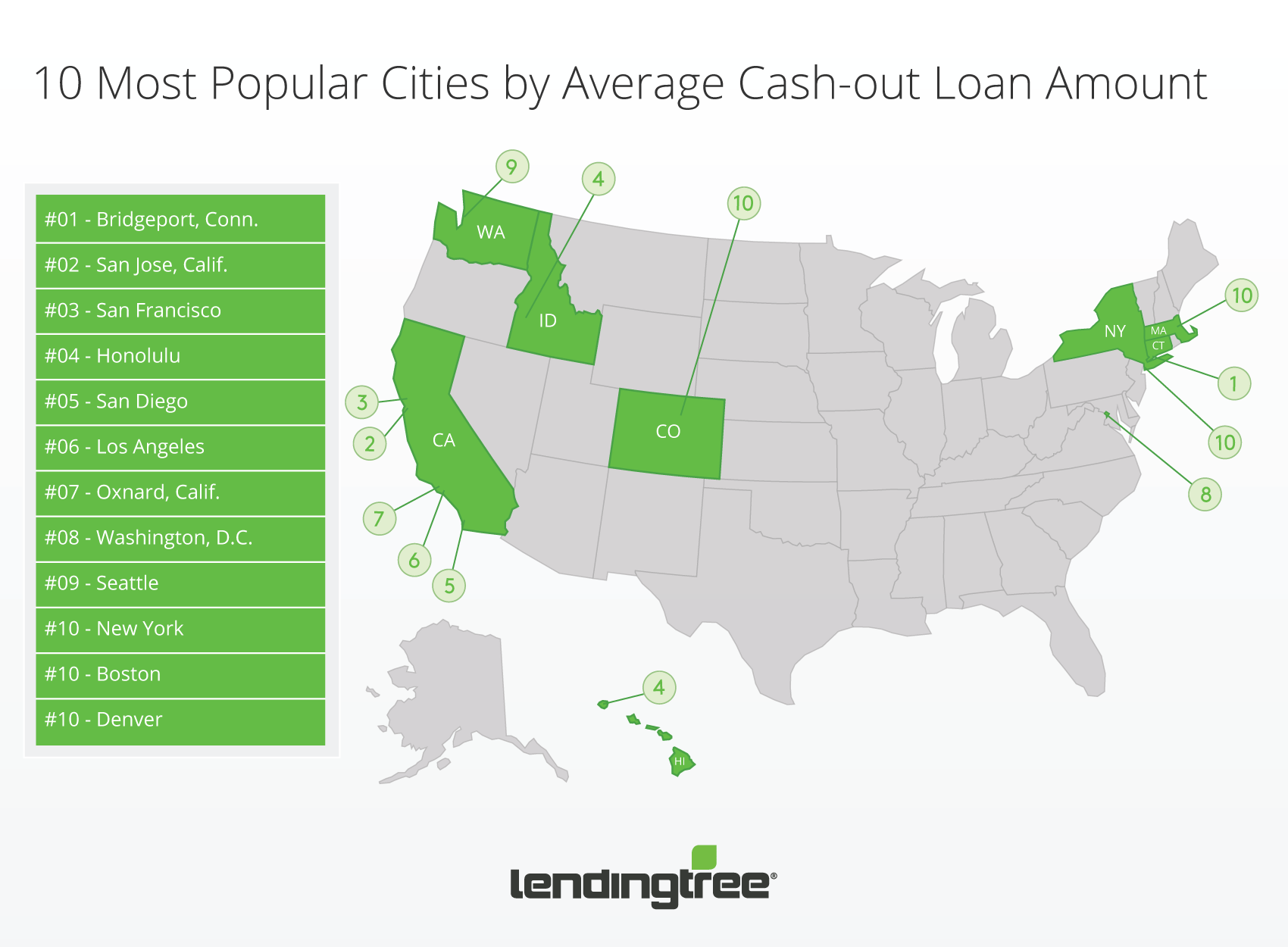
It was interesting that there were no regional trends we could identify among the cities with the most cash-out refinance borrowers, though loan amounts clearly line up with cities that have the highest home values, as would be expected. Opportunities for cash-out can result from long housing tenure or rapid price appreciation, or a combination of the two.
For borrowers, it really boils down to an individual decision, so let’s look at what a borrower should consider when thinking about getting a cash-out refinance.
How borrowers can tap the equity in their home
There are three primary ways to access the equity built up in the home:
#1 Cash-out refinance: the subject of our study, this replaces a current mortgage with a new one of a higher balance with the borrower receiving the difference in cash. The key advantages of a cash-out refinance are:
- Lower interest rate. Because the cash-out refinance is a first lien mortgage, it will have a lower rate than a HELOC or home equity loan.
- Tax deductibility. A cash-out refinance will be eligible for an interest tax deduction up to a balance of $750,000, so long as the funds were used to build or substantially improve the home.
A disadvantage to consider is that the closing costs will be larger as the loan amount is typically greater than a HELOC or home equity loan.
#2 Home equity loan: This a lump sum loan based on the equity available in your home. The monthly payments are fixed as is the interest rate. As we have reported, interest paid on HELOCs and home equity loans are tax-deductible so long as the funds were used to substantially improve the home in some way. So long as you meet that criteria, you can deduct interest paid on debt up to $750,000 (for married couples) or $375,000 (individuals).
#3 Home equity line of credit (HELOC): This is similar to a credit card, with the amount available to borrow dictated by the equity in your home. You can borrow money and pay it down as needed, though you will have a minimum due once you start to borrow. The payments vary with the amount outstanding and the interest rate can be variable as well.
Borrowers should educate themselves on the differences between cash-out refinance, home equity loans and HELOCs and select the one best for their circumstances. The table below compares the three options in more detail.
Cash-Out Refi vs. HELOC vs. Home Equity Loan
| How are they different? | |||
| Cash-Out Refinance | HELOC | Home Equity Loan | |
| Loan Term | You can refinance your home in any loan term up to 30 years. | Loan terms for HELOCs can vary. However, many last for up to 20 years. | Home equity loans can range from 5-20 years. |
| Borrowing limits | You can usually borrow up to 80 percent of your home’s value, although lender requirements vary. | The Federal Trade Commission (FTC) reports you may be able to borrow up to 85 percent of your home’s value (in total) depending on your creditworthiness. | Some lenders may let you borrow up to 90 or 95 percent of your home’s value across your first mortgage and home equity loan. |
| How long it takes to get the money | You may receive a lump sum of money once your new home loan closes. The loan process can take a few weeks to a few months. | You get access to a line of credit once your HELOC closes with the bank. Withdraw cash as needed. The loan process can take a few weeks to a few months. | You usually get a lump sum payout when your home equity loan closes, although not all home equity loans fund right away. The loan process can take a few weeks to a few months. |
| Credit score | You typically need a good FICO score (670+) to qualify, although you may qualify for an FHA cash-out refinance if you have a lower credit score. | You typically need a good credit score (670+) to qualify for a HELOC with the best rates and terms. You may qualify for a HELOC with a FICO score of 620 or more, however. Lender requirements vary. | You typically need a good credit score (670+) to qualify for a home equity loan with the best rates and terms. However, lender requirements vary. |
| Equity rules | You typically need at least 20 percent equity in your home after your cash-out refinance closes. | Most lenders allow you to borrow up to 85 percent of your home’s value including both your first mortgage and a HELOC. | You may be able to borrow up to 95 percent of your home’s value across a first mortgage and home equity loan, although lender requirements vary. |
| Interest Rates | Fixed or variable (See current mortgage rates in your area) | Variable (See current HELOC rates in your area) | Fixed (See current home equity loan rates in your area) |
| Closing Costs | Closing costs are typically hefty for a cash-out refinance since you’re getting an entirely new mortgage. Costs can include, but aren’t limited to, appraisal fee, attorney and title company fees, credit report fee, discount points, inspection fee, loan origination fee, title insurance fee, title search fee and recording fees. These costs can add up to 2-4 percent of the home’s purchase price. | HELOC closing costs can include an application fee, title search, appraisal, attorneys’ fees and points. They are typically 2 – 5 percent of the loan. | Closing costs typically cost 2- 5 percent of the cost of the loan. |
| Risk Level | Risk is low, provided you can afford to repay your new home loan. Keep in mind, however, that since your home is still used as collateral, you can lose your home if you stop making payments. | Risk is fairly low if you can afford to make monthly payments. However, you put your home at risk any time you use it as collateral. | Risk is fairly low, provided you can make monthly payments. However, you put your home at risk any time you use it as collateral. |
